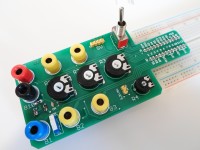T-Board Adapter

A T-Board for training students. I designed this T-Board because of the lack of useful terminals on the breadboard...
Because of the lack of useful terminals on the breadboard, I designed this T-Board.
Breadboard protoyping is often used in the field of education.
As there do not exist any useful terminals to connect the breadboard to external power supply or measurement equipments, it was for example difficult to show the students in a practical way how to realize simple breadboard circuits.
This T-board which was built to provide useful terminals for your breadboard, makes it easy to conntect supply and measure equipments with standard connecting cables.
The terminals which are linked to the T-board 2x12-pin connectors, fit on a standard bread-board.
The distance between the yellow banana-terminals is 19mm which allows to use a banana – BNC Adapter.
Additionally, the T-board includes a switch, some trimpots and a 1x4 pinheader.
On the bottom of the PCB there is a DC standard powerplug connector which can also be used to supply the bread board with an onboard 3.3V/5V voltage regulator.
Breadboard protoyping is often used in the field of education.
As there do not exist any useful terminals to connect the breadboard to external power supply or measurement equipments, it was for example difficult to show the students in a practical way how to realize simple breadboard circuits.
This T-board which was built to provide useful terminals for your breadboard, makes it easy to conntect supply and measure equipments with standard connecting cables.
The terminals which are linked to the T-board 2x12-pin connectors, fit on a standard bread-board.
The distance between the yellow banana-terminals is 19mm which allows to use a banana – BNC Adapter.
Additionally, the T-board includes a switch, some trimpots and a 1x4 pinheader.
On the bottom of the PCB there is a DC standard powerplug connector which can also be used to supply the bread board with an onboard 3.3V/5V voltage regulator.




Discussion (2 comments)
Richard Poandl 8 years ago
JohnHind 8 years ago
I would redesign this board layout so it was wider than the breadboard and had two extensions over it at the edges rather than one in the center as at present. This way, pins on the board could connect directly to the power buses on both sides and also to the same connection strips as at present but covering only the outermost contact holes without occluding any others. By overhanging the edges of the breadboard, you could make as much room as necessary for board layout. There are however at least two different breadboard designs on the market with a different relationship between the bus holes and the strip holes - this could be accomodated by providing duplicate board pads positioned for each and only actually fitting pins in the appropriate holes for the specific breadboard.
I realise it may be too late for this input as you seem to already have a PCB made. Would it not be possible to put designs up here much earlier in the design cycle so input from readers can influence the design?
Hans Gans 8 years ago
thanks a lot for your remarks concerning my T-board.
You are absolutely right with your remark that a some number of contacts are occluded. But the circuits I am going to build with the students won´t be that extensive, so it will do for my purpose. Nontheless I will take your hint into consideration when planning a subsequent T-Board.
Your idea with building the breadboard in U-form is rather good! Thanks for that! When redesigning the board I will seriously take that suggestion into consideration and most probably take it into practice.
Thanks a lot for your commenting my T-Board!